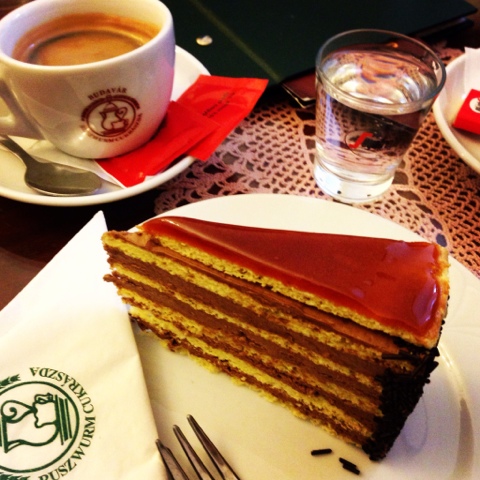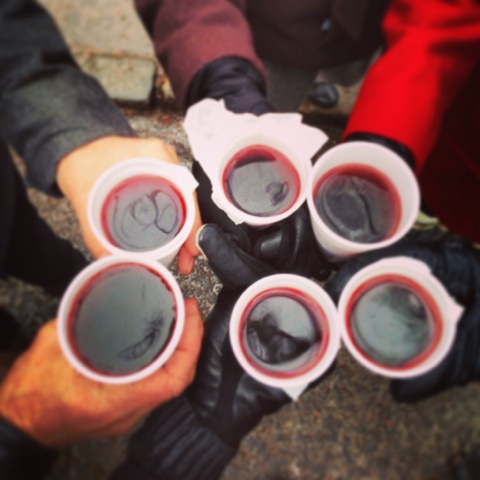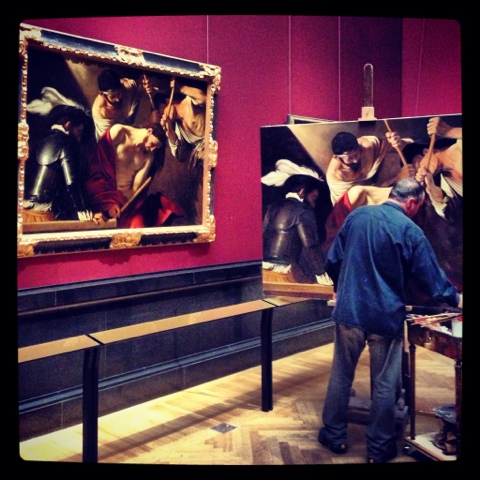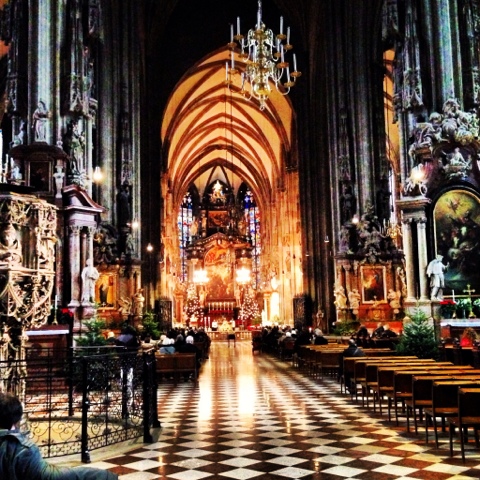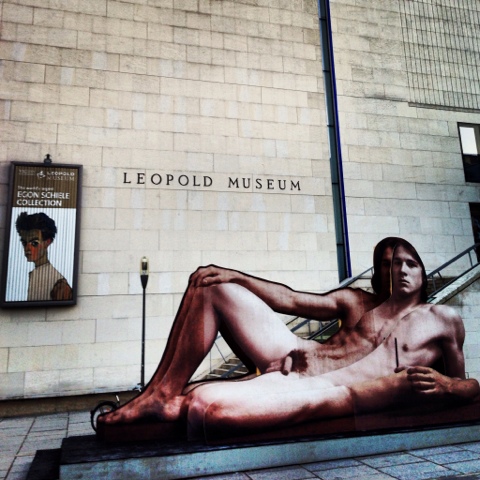Wishing everyone a happy and prosperous New Year from beautiful and wintery Europe! Here are some selected Instagram photos to give you a feel of what we are experiencing here in my family's hometown of Budapest, along with some images from our side trip to Vienna (only 2.5 short hours by train). Christmas markets, outdoor ice skating, hot mulled wine, family dinners, the opera, and of course, lots of art to enjoy and provoke discussion. Enjoy and see you in 2013!
Writing and Not Writing About the Art Market: The Fallout
 |
| Screen grab of the article that started the conversation... |
A few weeks ago while surfing my Twitter feed, I noticed a tweet from documentary filmmaker Ben Lewis, producer of The Great Contemporary Art Bubble, citing a "bombshell" announcement that Sarah Thornton was no longer reporting on the art world. He quoted her statement that summed up quite simply: "the art market is too corrupt to report on and I quit." I was immediately intrigued and being a huge fan of Thornton's writing I followed Lewis's link to an article Thornton published in the October edition of Tar Magazine titled "Top 10 reasons Not to write about the art market."I have summarized her points in a list here below:
1. It gives too much exposure to artists who attain high prices.
2. It enables manipulators to publicize the artists whose
prices they spike at auction.
3. It never seems to lead to regulation.
4. The most interesting stories are libelous.
5. Oligarchs and dictators are not cool.
6. Writing about the art market is painfully repetitive.
7. People send you unbelievably stupid press releases.
8. It implies that money is the most important thing
about art.
9. It amplifies the influence of the art market
10. The pay is appalling.
 |
| Sarah Thornton became well known for her study of the institutions making up the art world in her wonderfully written Seven Days in the Art World (2008) Image courtesy: Canadian Art |
Moreover, Schwendener's observations only reinforce Thornton's ten points:
"What all of these shows do, however, is return protest and activism to the white cube and institutions funded, as Occupy Museums points out, by the very people the art work theoretically rails against. "Stop using my art to wash your money," one participant said at Momenta. But this happens all the time…Like other fields, art has a serious money and institution problem that reached a breaking point under neoliberalism. What past art movements taught us is that changing the medium or the definition of an artist doesn't help."
 |
| Christie's auction of a Renoir painting in October-- it wasn't even over and the price was already well over $4 million. Image courtesy: UK Telegraph |
As a final note, I absolutely love this 2011 interview with Thornton posted below. Here, much like in her recent article, she offers up candid, honest, and valuable assessments concerning the art world in straight-forward and concise language. In particular, Thornton convincingly argues that too much time is taken up talking about whether people "like" particular kinds of art versus understanding the way art is deployed as a potent form of cultural capital (Ah yes-- this really *is* the task of any good art historian afterall). She also describes how and why she decided to combine her skills in sociology and art history to arrive at her eye-opening accounts of the mechanisms, interests, and power mongering within the contemporary art world-- a fascinating topic in and of itself. But in the end, and despite any misgivings she now has about the subject she has spent so much time invested in, Thornton does share one pearl of wisdom that I think is worth repeating here: "A successful artist is one who doesn't feel bitter." Words to live by, in my humble opinion, whatever your profession.
Further Reading:
Horowitz, Noah. Art of the Deal: Contemporary Art in a Global Financial Market. Princeton University Press (2011).
Thompson, Don. The $12 Million Stuffed Shark: The Curious Economics of Contemporary Art. Palgrave Macmillan (2010).
Thornton, Sarah. Seven Days in the Art World. W.W. Norton and Company (2009).
Quick Compare | Cindy Sherman, Martha Rosler, and Vogue Magazine
 |
| Cindy Sherman, Self-Portrait for French Vogue (2007) Image courtesy: Artobserved |
Here, Rosler anticipates the emerging post-feminist position that has been unwilling to fully interrogate (or at least come to some reasonable terms with) the resilient and seductive world of commodities targeting female consumers. One need only point to any episode of the popular "Real Housewives" franchise to see this phenomenon in action. Indeed, it is hard not to notice Rosler's fingers caressing each page of the magazine as she works through her monologue. This of course is at the core of the performance's powerful statement. With Sherman, we see Rosler's radical critique morph into a situational and fully postmodern intervention that dramatically positions the artist on the actual pages of Vogue. It is important to know that Sherman was invited and encouraged to produce her own performative fashion shoot using the very commodity items and media forms that had been a source of Rosler's critique. In the end, Sherman's difficult to categorize pictures (one wonders if the irony of the images is lost on Vogue readers-- Sherman does not really comment on this issue in her interview and discussion of the editorial below) further highlights the problematic and contradictory forces that inform present-day feminist politics.
Interestingly enough, and to add to the complexity surrounding these related performances, Rosler's video was recently screened as part of MoMA's contribution to the "Fashion Night Out" event that happens annually during New York Fashion Week. In November Rosler will have her much anticipated first solo exhibition at MoMA and is planning a large-scale version of an American style garage sale where she will display and sell second-hand goods to visitors. Rosler is also soliciting donations and, as the ad for the video screening promises without a hint of irony, "contributors will receive a 20% discount at the MoMA store!" I have no doubt that Rosler knows exactly what she is doing-- stay tuned.
 |
| Screen grab from Martha Rosler's upcoming solo exhibition at MoMA-- a live garage sale is planned. Image courtesy: MoMA |
Brunsdon, Charlotte. “Feminism,Postfeminism, Martha, Martha, and Nigella”
Cinema Journal , Vol. 44, No. 2 (Winter, 2005), pp. 110-116.
Sprague-Jones, J. and Sprague, J. “The Standpoint ofArt/Criticism: Cindy Sherman as Feminist Artist?” Sociological Inquiry, 81:
2011, 404–430.
New Courses for Spring 2013: Topics in Modern/Postmodern Architecture and Avant-Garde Film
As registration for Spring 2013 academic courses begins
soon, I wanted to provide more information about new courses I will begin teaching
in January. Please see detailed descriptions below including a new special
topics class in the History of Architecture (1700-present), and the History of
Avant-Garde Film. If you have any specific questions that are not answered here
or in the links I provide you to the registration for the courses, you can contact me directly. I look forward to another rich
and engaging semester with both new and familiar faces.
This course traces the history of architecture from the period of the late Baroque in the eighteenth century through to the postmodern architectural styles associated with the contemporary present, approaching architecture as a unique medium with its own visual vocabulary and spatial codes. The various formal languages, designs, and theories that have shaped the history of architecture will be explored through the close examination of select buildings and spatial environments set within specific cultural, social, political and economic contexts of their planning and construction. The broader purpose of this course is to provide students with the ability to critically evaluate and recognize how the history and theory of architecture, especially as it evolved through periods of emerging nationalism, industrialization, urbanization, and modernism within the framework of a broader global visual culture and art history, continue to impact our collective spatial, visual, intellectual and cultural environments today.
The avant-garde movements of the late nineteenth and
twentieth centuries have been determining forces in shaping collective ideas
about artistic practice and culture, social history, and subversive
intent. Not surprisingly, the technology of motion pictures has provided avant-garde
practitioners with a dynamic new medium to explore a range of themes and
philosophies, linking filmic experimentation with important ideas emerging in
the modern and contemporary art of the past century.
Kwantlen Polytechnic University (Mondays 4:00-6:50pm, Room
Fir 3414)
 |
| Norman Foster, Reichstag interior, Berlin (1993) |
This course traces the history of architecture from the period of the late Baroque in the eighteenth century through to the postmodern architectural styles associated with the contemporary present, approaching architecture as a unique medium with its own visual vocabulary and spatial codes. The various formal languages, designs, and theories that have shaped the history of architecture will be explored through the close examination of select buildings and spatial environments set within specific cultural, social, political and economic contexts of their planning and construction. The broader purpose of this course is to provide students with the ability to critically evaluate and recognize how the history and theory of architecture, especially as it evolved through periods of emerging nationalism, industrialization, urbanization, and modernism within the framework of a broader global visual culture and art history, continue to impact our collective spatial, visual, intellectual and cultural environments today.
All of the buildings under examination (which will introduce
and cover aspects of architecture, spatial planning, and styles associated with
the Baroque, Neo-Classical, Gothic Revival, Arts and Crafts, and Art Nouveau
movements in Europe and North America, together with radical breaks seen in the
turn to globalizing Modern and Post-Modern architecture in the practices of Le
Corbusier, Walter Gropius, Frank Lloyd Wright, Robert Venturi, Peter Eisenman,
Frank Gehry and others) will be related to their original contexts, but also
raise questions about the range of functions that architecture might fulfill
within different societies. While the primary focus of the course will be on
Western architecture and culture, the architecture of the Middle East, Asia,
the Americas and Africa will also be explored through targeted readings and
lectures. The course will therefore not just be about following a chronological
and progressive trajectory of “great buildings” and “great architects” but will
instead address broad issues related to political power, gender, sexuality,
race, and the formation of individual and group identities. In this way, the
ideas raised in this course will also draw attention to the dynamics and
ongoing debates concerning what it means to make a building and design a space
in any cultural context.
Kwantlen Polytechnic University (Tuesdays 4:00-6:50pm, Room
Fir 3414)
 |
| Andy Warhol, Screen Test (Edie Sedgwick) (1964) |
Beginning with an examination of film’s critical role in the
development of modern art and the history of the avant-garde, this course will draw
from existing issues and debates concerning art history and the expanding field
of visual culture linked through a number of filmic subgenres (such as
abstraction, collage, Dadaism, appropriation, surrealism, structuralism,
duration, parody, camp, autobiography and expanded cinema). In this way, the
course also offers a critical examination of selected films in connection to
key theoretical and historical turning points in art history and critical
theory and will roughly follow the history and theory of visual arts as it
moves from the emergence of the modern period in Europe through the demise of
modernism following WWII and into the areas of post-modern intervention leading
to our contemporary present. Artists and filmmakers under examination include,
but are not limited to, Germaine Dulac, Marcel Duchamp, Sergei Eisenstein, Jean
Cocteau, Hans Richter, Man Ray, Jean-Luc Godard, Stan Brakhage, Akira Kurosawa,
Shirley Clarke, Robert Smithson, Chantal Akerman, Andy Warhol, Yoko Ono, David
Lynch, Doug Aitken, Stan Douglas, Doug Aiken, Matthew Barney, Pipilotti Rist,
Kenneth Anger and Matthew Barney.
Weekly Twitter|YouTube Round Up
 |
| Ai Weiwei goes Gangnam style to the delight of audiences worldwide (see tweet and YouTube video below) |
Another week done and we find ourselves over the midterm hump and ready to dive into the meaty part of the fall semester. I have been doing a lot of marking and evaluating this weekend along with enjoying the best of the Halloween season (i.e. scary movies and treats). Take a quick break and enjoy some of my picks from around the Twitterverse. As a new feature, I've also decided to add some of my favourites from around YouTube land into the weekly mix-- now that there are so many more art-related videos popping up on my subscription feeds, I want to pass along some worthy picks to compliment the Twitter links. Enjoy and have a safe and Happy Halloween this week!
Garage (Art) Sale: Martha Rosler to fill the @MuseumModernArt with
12,000 donated objects to sell for charity
New film technology may be the death of Vancouver
theatres
Art exhibit in Seattle replaced all work by male artists
with work solely by female artists for new exhibition
100 ideas that changed art
I would just like to point out that @metmuseum has put hundreds of
PDFs of out of print art books online. #gratis
UbuWeb has just added over 150 films
Ai Weiwei goes 'Gangnam Style' in video tribute to Psy


